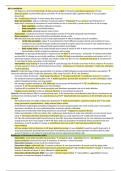College aantekeningen
Cognitive Neuropsychiatry Full Exam Notes - Utrecht University
- Instelling
- Universiteit Utrecht (UU)
Cognitive Neuropsychiatry Exam notes covering all topics: Body perception in Anorexia, Dissociative Disorders, Borderline Personality Disorder, Post Traumatic Stress Disorder, Schizophrenia Spectrum Disorder, Hallucinations, Psychosis, Aggression, Psychopathy, Social Hierarchy, Aggression, Morality...
[Meer zien]




